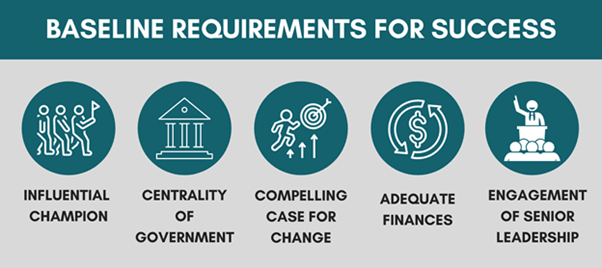After work in management and leadership development with 11 TLCC cohorts, we at Spark Health Africa are expanding our scope to take advantage of our expertise in mediating difficult conversations with diverse stakeholders to pursue a common goal. We aim to strengthen the healthcare system by creating a collaborative stakeholder ecosystem in pursuit of collective impact.
This article explains why deepening collaboration is imperative for change and how pursuing collective impact will strengthen the overall healthcare system. We also describe our framework for achieving collective impact, focusing on our inaugural Collective Impact program working on the Community Health Platforms Approach in Kenya which the Johnson & Johnson Center for Health Worker Innovation (CHWI) is spearheading.
The Johnson & Johnson Center for Health Worker Innovation (the Center) was founded to catalyze efforts to respond to the human resource crisis in global health and build a thriving health workforce. The Center is committed to support one million nurses, midwives and community health workers reaching 100 million people by 2030. Working with partners, the Center is developing a global portfolio of programs in regions with the highest community health burdens and frontline health worker gaps, while also ensuring that the current health workforce is thriving and resilient.

The Case for Change
Despite financial investments into the African public sector, there is still no resolution to the many barriers preventing good health and well-being for all. It is becoming clear that increasing financial resources alone is not the panacea to solving the multiplicity of challenges characterizing the fragmented and siloed African public health sector. With more than a decade of work in various African public health sectors, we have observed that contributors to the fragmentation of the health system include ineffective coordination and collaboration as well as inadequate involvement of government to drive the agenda. This is partly due to managers in the healthcare space who find themselves in positions of leadership with little to no access to leadership and management training.
Being the primary custodian of the public health system, the government requires strong leadership to set national priorities. Ideally, the government should be the entity that coordinates support and ensures alignment on strategic priorities between diverse stakeholders, including civil society, funders, and implementing partners at the global, regional, and local levels. However, the African public health sector ecosystem is far from this ideal. A leadership vacuum is often created with the government taking a back seat and leaving room for funding partners to bring in their priorities and timelines. Often these priorities and timelines are misaligned with those of the government.
Funding partners exacerbate the leadership vacuum by encouraging competitiveness between implementing partners by selecting grantees based on the extent to which an individual organisation can impact a limited set of disparate priorities. In response to this, implementing partners propose interventions that focus on one or a few factors, with the expectation that by addressing those factors, the overall performance of the health system will be impacted. They make every effort to isolate their contribution to demonstrate impact and therefore justify resources used.
Fragmentation in the healthcare sector also means that action planning by various partners is not coordinated which promotes a siloed work culture. This isolated approach results in inefficient utilization of the limited resources available. Consequently, each stakeholder’s contributions are undermined, leading to work that is not as impactful as it could have been. This sub-optimal return in turn frustrates funders who have very little to show for their investments. For example, one partner focusing on maternal health could lead to very safe deliveries. However, a system gap in early childhood vaccines still results in few of those babies reaching maturity, and therefore, universal healthcare is not achievable.
This siloed approach often does not result in the desired outcome because multiple factors need to be addressed concurrently and in a coordinated manner to have meaningful improvements at a systems level. Ideally, partner activities should be mutually reinforcing to simultaneously work towards improving the healthcare system in a way that addresses all aspects of a patient’s health.

A move towards Collective Impact (CI)
We need to move away from approaches that promote one intervention as the panacea (isolated impact), and gravitate towards a combination of interventions (collective impact). This shift requires that individual organisations re-envision their agenda in favor of a shared agenda that aligns efforts, resulting in collective impact.
The Johnson and Johnson (J&J) Centre for Health Worker Innovation Foundation adopted the ‘Platform Approach’ based on the realization that large scale social change cannot be achieved by one organization, nor can the efforts be funded by one donor or government. J&J sought to promulgate this way of thinking through the Platforms Approach, to bring together multi-sector stakeholders around a common agenda of strengthening community health for universal health coverage. By so-doing, donor funds are highly leveraged as implementing partners work together in a mutually reinforcing manner towards delivering the same goals.
This Platforms Approach is expected to bring about large-scale social change in community health and deliver on goals that have, in the past, been very slow to be realized. It is also anticipated to foster cross-fertilization of ideas at the implementation level amongst partners. Most importantly, the government will be able to effectively implement the community health strategy with the confidence that they will have coordinated and streamlined support from its implementing partners.
“My call is: Can we work together to first establish a community health system that is agnostic to any intervention area? Once this is in place, can we add on the supporting systems in a cohesive way within one plan in every country that we work in? That is what will lead to the success of community health and for the health system in general,” – Anthony Gitau, director of global community impact sub-Saharan Africa, Johnson & Johnson speaking on the Platforms Approach
Building blocks for successful implementation of a Collective Impact initiative
Spark Health Africa has been involved in the Kenya Platforms Approach initiative as a strategic partner to Johnson & Johnson by providing strategic and thought leadership in the development of the platform architecture, mediation of dialogue, and driving transformative thinking amongst partners around strengthening the contribution of Community Health Services to Primary Health Care. We see our role as critical to translating radical collaboration in theory to actual practice.
Initially, our work focused on understanding the context within which partners support the government and identifying barriers to collaboration. The landscape was characterized by an indifference to intentionally fostering collaboration among implementing partners in an environment where a siloed approach to supporting the government was considered the norm. Our iterative process of mediating difficult conversations between partners to uncover the source of competitive behaviour has taught us important lessons about the necessary building blocks to forge Collective Impact in the Community Health landscape in Kenya. While each context is different, we believe that these lessons provide insights that could be useful for other Collective Impact initiatives to consider.

The presence of an influential champion(s).
The influential champion initiates the platform by bringing on board other key influencers in the health sector to commit to the vision of the platform. These champions will include government, funders, and implementing partners that command respect in the Community Health landscape. In Kenya, Johnson & Johnson were the founding champion, bringing on board the Ministry of Health Division of Community Health and other influencers such as UNICEF. They see themselves as the rainmakers, planting the seed and allowing the Platform to grow beyond their financial contributions, thus making it a sustainable model.
Centrality of government
Government ownership is central from the onset as the primary custodian of the public health sector. The government understands the contextual challenges and has the authority to bring different stakeholders together. Initially, in Kenya, the convening role had been assigned to an implementing partner. Although government was involved in the initial planning meetings, participation declined to eventually no representation of government. Not having the voice of government posed the risk of the platform pursuing activities that were not necessarily deemed a priority by the government. Corrective action was taken, which saw the government represented by a manager from the Division of Community Health being assigned as the convener. This step resulted in an immediate increase in participation by different stakeholders because of the authority brought by government led convenings.
Compelling Case for Change
The case for change must be context-specific and must create a sense of urgency for shifting to greater collaboration. Stakeholders must be able to see how they will contribute to the problem being addressed as well as the goals and vision of the Platform. Furthermore, they must also clearly answer the “What’s in it for me?” question.
The case for change should also reflect the challenges that a particular country is grappling with. In Kenya, the Platform partners addressed the COVID 19 pandemic which presented the first issue that needed a collective approach. Developing the position paper for community health in the COVID 19 response became the first rallying activity for the Platform partners
However, several months into the pandemic’s first wave, members felt this was no longer compelling enough. The lack of a clearly defined case for change and the accompanying strategic framework beyond COVID-19 meant untapped potential of collective effort. In the absence of a clearly defined problem and a unifying strategic framework with shared measurement and accountability systems stakeholders tend to focus on what they each perceive to be important. This undermines the essence of collective impact. Corrective action is currently underway to clearly define the unifying problem that Platform members can rally behind.
Adequate Finances
To set up a well-functioning platform requires financial resources. This can be in the form of an anchor funder, like Johnson & Johnson, in the Kenya Platform case. Existing funders can mobilize other like minded funding partners to fund the needed infrastructure and planning processes, as well as fund learning through innovation and experimentation. This ensures continuity and sustainability of the initiative beyond the anchor funder.
Engagement of Senior Leadership
GutIt is crucial that the Platform is anchored at the senior management level to give it the weight it requires with influential decision-makers, particularly in the early stages of development. Failure to engage at the senior management level leads to the collective impact agenda being de-prioritised. Senior management’s deep involvement in the initiation and development of the Platforms Approach strategic framework sends a signal to potential champions that the Platform is of strategic importance, which should be prioritized.
Spark Health Africa future Catalyzing Collective Impact
At Spark Health Africa, we are passionate about driving the practice of collaboration. We have experience in spearheading the architecture development and the institutionalisation phases, having piloted this approach in Malawi. We were a strategic thought partner to the government in bringing together implementing partners in the Southern region of Malawi to work collaboratively which resulted in increased early infant HIV diagnosis. We have partnered with Johnson & Johnson in driving the collective impact approach in Kenya and South Africa.
Our vision is to expand our footprint, initially leveraging existing partnerships in East and Southern Africa. To this end, we invite funding partners and governments to partner with us to enhance efficient use of resources through the collective impact approach.
What to read next from Spark Health Africa:
Subscribe to our newsletter
